Combustion and Performance Study of Low-Displacement Compression Ignition Engines Operating with Diesel–Biodiesel Blends
Abstract
1. Introduction
2. Diagnosis Model Description
2.1. Diagnostic Model Considerations
- Uniform pressure inside the combustion chamber. This assumption is valid because the velocity of fluid propagation and the velocity of the combustion flame are much lower than the velocity of the sound [29].
- The gases inside the combustion chamber have an ideal gas behavior. Valencia et al. [30] demonstrated the validity of this assumption in internal combustion engines.
- The specific heat of the gases depends only on the chemical composition and temperature. This assumption is the result of the above consideration, as it is assumed to be a blend of ideal gases.
- The combustion products are calculated stoichiometrically. This assumption is valid since most of the combustion process in the chamber of a diesel engine is diffusion combustion. Therefore, the consideration of stoichiometric combustion is valid [31].
- Thermodynamic properties are calculated at the mean temperature of the combustion chamber. This assumption is valid since the phenomena of diffusion and heat transfer tend to stabilize the temperature uniformly inside the chamber.
- Heat transfer through the cylinder walls and deformations of the piston mechanism are taken into consideration above to obtain results closer to the nature of the phenomenon.
2.2. Fundamental Equations of the Diagnostic Model
2.2.1. Engine Energy Balance
| Work is done inside the combustion chamber. | |
| Change of internal energy in the combustion chamber. | |
| Heat rejected by convection of the combustion chamber. | |
| Energy associated with fuel injection and vaporization. | |
| Flow work associated with losses due to leaks in the combustion chamber. | |
| It is the total energy generated by the fuel injected during the cycle. |
2.2.2. Mass Balance in a Closed Cycle
2.2.3. Model of Gas Properties
2.2.4. Heat Transfer Model
2.2.5. Combustion Chamber Volume Model
2.2.6. Blow-By Losses
3. Diagnostic Model Procedure
4. Experimental Setup and Procedure
4.1. Experimental Instruments
4.2. Test Conditions and Fuels
5. Results and Discussion
5.1. Combustion Characteristics
5.1.1. Cylinder Pressure
5.1.2. Heat Release Rate (HRR)
5.1.3. Cumulative Heat Release Rate
5.1.4. Combustion Chamber Temperature
5.2. Engine Performance
5.3. Emission Characteristics
5.3.1. CO and CO2 Emissions
5.3.2. NOx and HC Emissions
5.3.3. Smoke Emissions
6. Conclusions
Author Contributions
Funding
Acknowledgments
Conflicts of Interest
Abbreviations
| LHVfuel | Lower heating value of fuel |
| HRR | Heat release rate |
| IVC | Inlet valve close |
| EVO | Exhaust valve open |
| BSFC | Brake specific fuel consumption |
| BTE | Brake thermal efficiency |
| B5 | 5% biodiesel blend |
| B10 | 10% biodiesel blend |
| CO | Carbon monoxide |
| CO2 | Carbon dioxide |
| NOx | Nitrogen oxides |
| HC | Hydrocarbons |
| HSU | Hartridge Smoke Unit |
| Nomenclature | |
| P | Mean combustion chamber pressure |
| V | Combustion chamber volume |
| m | Gas mass |
| Cv | Specific heat at constant volume |
| T | Combustion chamber gas temperature |
| Q | Heat release |
| Qr | Heat rejected by convection |
| Qc | Heat release during the combustion process |
| h | Specific enthalpy |
| R | Ideal gas constant |
| U | Internal energy |
| u | Specific Internal Energy |
| Y | Gas Mass Fraction |
| AW | Heat transfer surface area of the combustion chamber |
| D | Diameter |
| L | Length |
| rc | Compression ratio |
| Kdef | Deformation constant |
| R4y | Vertical position of the piston |
| Esteel | Elastic modulus of steel |
| A | Area |
| ACR | Connecting rod’s critical area |
| ac | Acceleration |
| e | Eccentricity between the stump and the bearing, located in its center line |
| M | Gas molecular weight |
| Greek Letters | |
| θ | Crankshaft angle |
| ρ | Fluid density |
| Subscripts | |
| 4 | Piston |
| comb | Combustion chamber gas |
| a | Air |
| b | Combustion Products |
| f | Fuel |
| fl | Liquid fuel |
| W | Combustion Chamber Wall |
| bb | Blow-by |
| inj | Injection |
| i | Inertial loads |
References
- Yoo, H.; Park, B.Y.; Cho, H.; Park, J. Performance Optimization of a Diesel Engine with a Two-Stage Turbocharging System and Dual-Loop EGR Using Multi-Objective Pareto Optimization Based on Diesel Cycle Simulation. Energies 2019, 12, 4223. [Google Scholar] [CrossRef]
- Tian, H.; Cui, J.; Yang, T.; Fu, Y.; Tian, J.; Long, W. Experimental Research on Controllability and Emissions of Jet-Controlled Compression Ignition Engine. Energies 2019, 12, 2936. [Google Scholar] [CrossRef]
- Dhar, A.; Agarwal, A.K. Effect of Karanja biodiesel blend on engine wear in a diesel engine. Fuel 2014, 134, 81–89. [Google Scholar] [CrossRef]
- Hirner, F.S.; Hwang, J.; Bae, C.; Patel, C.; Gupta, T.; Agarwal, A.K. Performance and emission evaluation of a small-bore biodiesel compression-ignition engine. Energy 2019, 183, 971–982. [Google Scholar] [CrossRef]
- Kumar, N.; Varun, G.; Chauhan, S.R. Performance and emission characteristics of biodiesel from different origins: A review. Renew. Sustain. Energy Rev. 2013, 21, 633–658. [Google Scholar] [CrossRef]
- Zahan, K.; Kano, M. Biodiesel Production from Palm Oil, Its By-Products, and Mill Effluent: A Review. Energies 2018, 11. [Google Scholar] [CrossRef]
- Bari, S.; Hossain, S.N. Performance and emission analysis of a diesel engine running on palm oil diesel (POD). Energy Procedia 2019, 160, 92–99. [Google Scholar] [CrossRef]
- Sajjadi, B.; Raman, A.A.A.; Arandiyan, H. A comprehensive review on properties of edible and non-edible vegetable oil-based biodiesel: Composition, specifications and prediction models. Renew. Sustain. Energy Rev. 2016, 63, 62–92. [Google Scholar] [CrossRef]
- Berchmans, H.J.; Hirata, S. Biodiesel production from crude Jatropha curcas L. seed oil with a high content of free fatty acids. Bioresour. Technol. 2008, 99, 1716–1721. [Google Scholar] [CrossRef]
- Thushari, P.G.I.; Babel, S. Biodiesel Production From Waste Palm Oil Using Palm Empty Fruit Bunch-Derived Novel Carbon Acid Catalyst. J. Energy Resour. Technol. 2018, 140, 1–10. [Google Scholar] [CrossRef]
- Sumathi, S.; Chai, S.P.; Mohamed, A.R. Utilization of oil palm as a source of renewable energy in Malaysia. Renew. Sustain. Energy Rev. 2008, 12, 2404–2421. [Google Scholar] [CrossRef]
- Kurnia, J.C.; Jangam, S.V.; Akhtar, S.; Sasmito, A.P.; Mujumdar, A.S. Advances in biofuel production from oil palm and palm oil processing wastes: A review. Biofuel Res. J. 2016, 3, 332–346. [Google Scholar] [CrossRef]
- Sulaiman, S.A.; Taha, F.F.F. Drying of Oil Palm Fronds Using Concentrated Solar Thermal Power. Appl. Mech. Mater. 2014, 699, 449–454. [Google Scholar] [CrossRef]
- Lam, S.S.; Tsang, Y.F.; Yek, P.N.Y.; Liew, R.K.; Osman, M.S.; Peng, W.; Lee, W.H.; Park, Y.-K. Co-processing of oil palm waste and waste oil via microwave co-torrefaction: A waste reduction approach for producing solid fuel product with improved properties. Process Saf. Environ. Prot. 2019, 128, 30–35. [Google Scholar] [CrossRef]
- Cho, H.J.; Kim, J.-K.; Cho, H.-J.; Yeo, Y.-K. Techno-Economic Study of a Biodiesel Production from Palm Fatty Acid Distillate. Ind. Eng. Chem. Res. 2012, 52, 462–468. [Google Scholar] [CrossRef]
- Liew, W.; Muda, K.; Azraai, M.; Affam, A.; Loh, S. Agro-industrial waste sustainable management–a potential source of economic benefits to palm oil mills in Malaysia. J. Urban Environ. Eng. 2017, 11, 108–118. [Google Scholar] [CrossRef]
- Ahmad Farid, M.A.; Hassan, M.A.; Taufiq-Yap, Y.H.; Ibrahim, M.L.; Othman, M.R.; Ali, A.A.M.; Shirai, Y. Production of methyl esters from waste cooking oil using a heterogeneous biomass-based catalyst. Renew. Energy. 2017, 114, 638–643. [Google Scholar] [CrossRef]
- Anuar, M.R.; Abdullah, A.Z. Ultrasound-assisted biodiesel production from waste cooking oil using hydrotalcite prepared by combustion method as catalyst. Appl. Catal. A Gen. 2016, 514, 214–223. [Google Scholar] [CrossRef]
- Hong, I.K.; Jeon, H.; Kim, H.; Lee, S.B. Preparation of waste cooking oil based biodiesel using microwave irradiation energy. J. Ind. Eng. Chem. 2016, 42, 107–112. [Google Scholar] [CrossRef]
- Ramírez, R.; Gutiérrez, A.S.; Eras, J.J.C.; Valencia, K.; Hernández, B.; Forero, J.D. Evaluation of the energy recovery potential of thermoelectric generators in diesel engines. J. Clean. Prod. 2019, 241, 118412. [Google Scholar] [CrossRef]
- Saydut, A.; Kafadar, A.B.; Tonbul, Y.; Kaya, C.; Aydin, F.; Hamamci, C. Comparison of the Biodiesel Quality Produced from Refined Sunflower (Helianthus Annuus L) Oil and Waste Cooking Oil. Energy Explor. Exploit. 2010, 28, 499–512. [Google Scholar] [CrossRef]
- Saifuddin, M.; Boyce, A.N. Biodiesel production from waste cooking sunflower oil and environmental impact analysis. Kuwait J. Sci. 2016, 43, 110–117. [Google Scholar]
- Elkelawy, M.; Alm-Eldin Bastawissi, H.; Esmaeil, K.K.; Radwan, A.M.; Panchal, H.; Sadasivuni, K.K.; Ponnamma, D.; Walvekar, R. Experimental studies on the biodiesel production parameters optimization of sunflower and soybean oil mixture and DI engine combustion, performance, and emission analysis fueled with diesel/biodiesel blends. Fuel 2019, 255. [Google Scholar] [CrossRef]
- Gupta, J.; Agarwal, M.; Dalai, A.K. Optimization of biodiesel production from mixture of edible and nonedible vegetable oils. Biocatal. Agric. Biotechnol. 2016, 8, 112–120. [Google Scholar] [CrossRef]
- De Almeida, V.F.; García-Moreno, P.J.; Guadix, A.; Guadix, E.M. Biodiesel production from mixtures of waste fish oil, palm oil and waste frying oil: Optimization of fuel properties. Fuel Process. Technol. 2015, 133, 152–160. [Google Scholar] [CrossRef]
- Costa, J.F.; Almeida, M.F.; Alvim-Ferraz, M.C.M.; Dias, J.M. Biodiesel production using oil from fish canning industry wastes. Energy Convers. Manag. 2013, 74, 17–23. [Google Scholar] [CrossRef]
- Valencia, G.; Núñez, J.; Duarte, J. Multiobjective optimization of a plate heat exchanger in a waste heat recovery organic rankine cycle system for natural gas engines. Entropy 2019, 21. [Google Scholar] [CrossRef]
- Diaz, G.A.; Forero, J.D.; Garcia, J.; Rincon, A.; Fontalvo, A.; Bula, A.; Padilla, R.V. Maximum Power From Fluid Flow by Applying the First and Second Laws of Thermodynamics. J. Energy Resour. Technol. 2017, 139. [Google Scholar] [CrossRef]
- Ochoa, G.V.; Isaza-Roldan, C.; Forero, J.D. A phenomenological base semi-physical thermodynamic model for the cylinder and exhaust manifold of a natural gas 2-megawatt four-stroke internal combustion engine. Heliyon 2019, 5, e02700. [Google Scholar] [CrossRef]
- Valencia Ochoa, G.; Acevedo Peñaloza, C.; Duarte Forero, J. Thermoeconomic optimization with PSO Algorithm of waste heat recovery systems based on Organic Rankine Cycle system for a natural gas engine. Energies 2019, 12, 4165. [Google Scholar] [CrossRef]
- Glassman, I. Combustion; Academic Press Inc.: Cambridge, MA, USA, 1987. [Google Scholar]
- Woschni, G. A Universally Applicable Equation for the Instantaneous Heat Transfer Coefficient in the Internal Combustion Engine. SAE Tech. Pap. 1967. [Google Scholar] [CrossRef]
- Woschni, G. Die berechnung der wandverluste und der thermischen belastung der bauteile von dieselmotoren. MTZ Mot. Z. 1970, 31, S491–S499. [Google Scholar]
- Consuegra, F.; Bula, A.; Guillín, W.; Sánchez, J.; Duarte Forero, J. Instantaneous in-Cylinder Volume Considering Deformation and Clearance due to Lubricating Film in Reciprocating Internal Combustion Engines. Energies 2019, 12. [Google Scholar] [CrossRef]
- Irimescu, A.; Di Iorio, S.; Merola, S.S.; Sementa, P.; Vaglieco, B.M. Evaluation of compression ratio and blow-by rates for spark ignition engines based on in-cylinder pressure trace analysis. Energy Convers. Manag. 2018, 162, 98–108. [Google Scholar] [CrossRef]
- Alptekin, E.; Canakci, M. Characterization of the key fuel properties of methyl ester–diesel fuel blends. Fuel 2009, 88, 75–80. [Google Scholar] [CrossRef]
- Agarwal, A.K.; Das, L.M. Biodiesel Development and Characterization for Use as a Fuel in Compression Ignition Engines. J. Eng. Gas Turbines Power. 2001, 123, 440–447. [Google Scholar] [CrossRef]
- Rosha, P.; Mohapatra, S.K.; Mahla, S.K.; Cho, H.; Chauhan, B.S.; Dhir, A. Effect of compression ratio on combustion, performance, and emission characteristics of compression ignition engine fueled with palm (B20) biodiesel blend. Energy 2019, 178, 676–684. [Google Scholar] [CrossRef]
- Asokan, M.A.; Senthur Prabu, S.; Bade, P.K.K.; Nekkanti, V.M.; Gutta, S.S.G. Performance, combustion and emission characteristics of juliflora biodiesel fuelled DI diesel engine. Energy 2019, 173, 883–892. [Google Scholar] [CrossRef]
- Musthafa, M.M.; Kumar, T.A.; Mohanraj, T.; Chandramouli, R. A comparative study on performance, combustion and emission characteristics of diesel engine fuelled by biodiesel blends with and without an additive. Fuel 2018, 225, 343–348. [Google Scholar] [CrossRef]
- Can, Ö. Combustion characteristics, performance and exhaust emissions of a diesel engine fueled with a waste cooking oil biodiesel mixture. Energy Convers. Manag. 2014, 87, 676–686. [Google Scholar] [CrossRef]
- Dueso, C.; Muñoz, M.; Moreno, F.; Arroyo, J.; Gil-Lalaguna, N.; Bautista, A.; Gonzalo, A.; Sánchez, J.L. Performance and emissions of a diesel engine using sunflower biodiesel with a renewable antioxidant additive from bio-oil. Fuel 2018, 234, 276–285. [Google Scholar] [CrossRef]
- Canakci, M. Combustion characteristics of a turbocharged DI compression ignition engine fueled with petroleum diesel fuels and biodiesel. Bioresour. Technol. 2007, 98, 1167–1175. [Google Scholar] [CrossRef]
- Murillo, S.; Míguez, J.L.; Porteiro, J.; Granada, E.; Morán, J.C. Performance and exhaust emissions in the use of biodiesel in outboard diesel engines. Fuel 2007, 86, 1765–1771. [Google Scholar] [CrossRef]
- Özener, O.; Yüksek, L.; Ergenç, A.T.; Özkan, M. Effects of soybean biodiesel on a DI diesel engine performance, emission and combustion characteristics. Fuel 2014, 115, 875–883. [Google Scholar] [CrossRef]
- Emiroğlu, A.O.; Şen, M. Combustion, performance and emission characteristics of various alcohol blends in a single cylinder diesel engine. Fuel 2018, 212, 34–40. [Google Scholar] [CrossRef]
- Abed, K.A.; Gad, M.S.; El Morsi, A.K.; Sayed, M.M.; Elyazeed, S.A. Effect of biodiesel fuels on diesel engine emissions. Egypt. J. Pet. 2019, 28, 183–188. [Google Scholar] [CrossRef]
- Ong, H.C.; Masjuki, H.H.; Mahlia, T.M.I.; Silitonga, A.S.; Chong, W.T.; Yusaf, T. Engine performance and emissions using Jatropha curcas, Ceiba pentandra and Calophyllum inophyllum biodiesel in a CI diesel engine. Energy. 2014, 69, 427–445. [Google Scholar] [CrossRef]
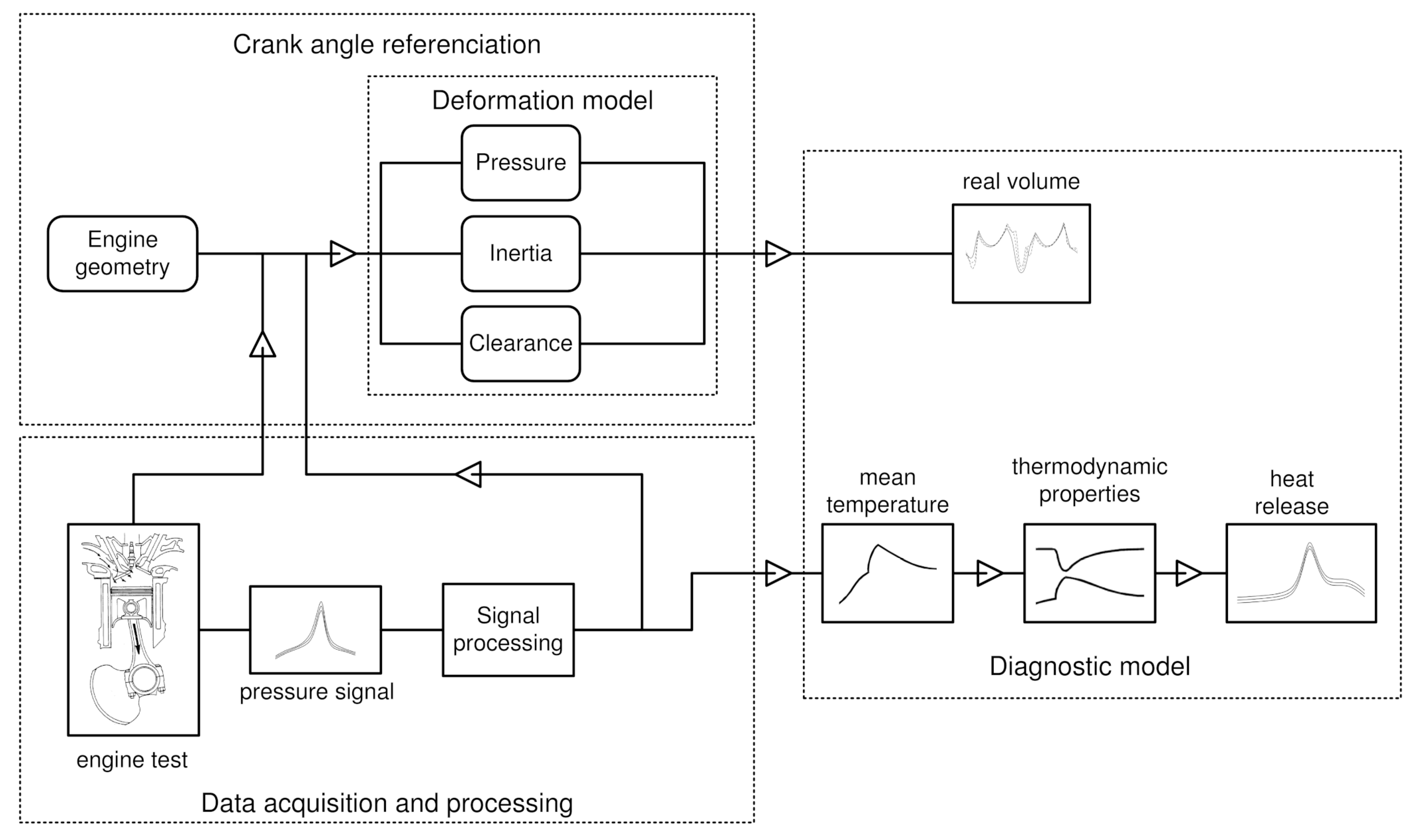
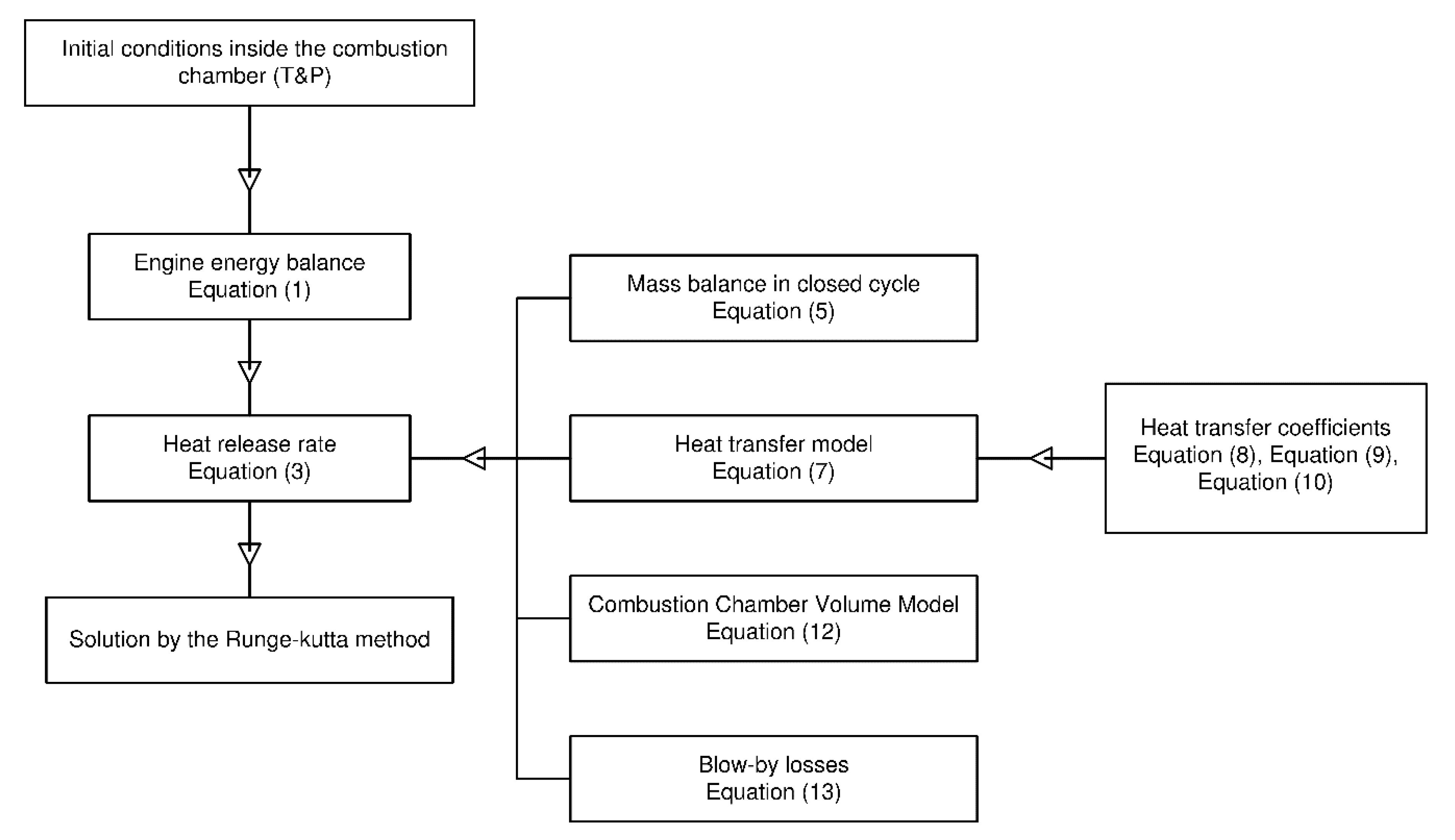

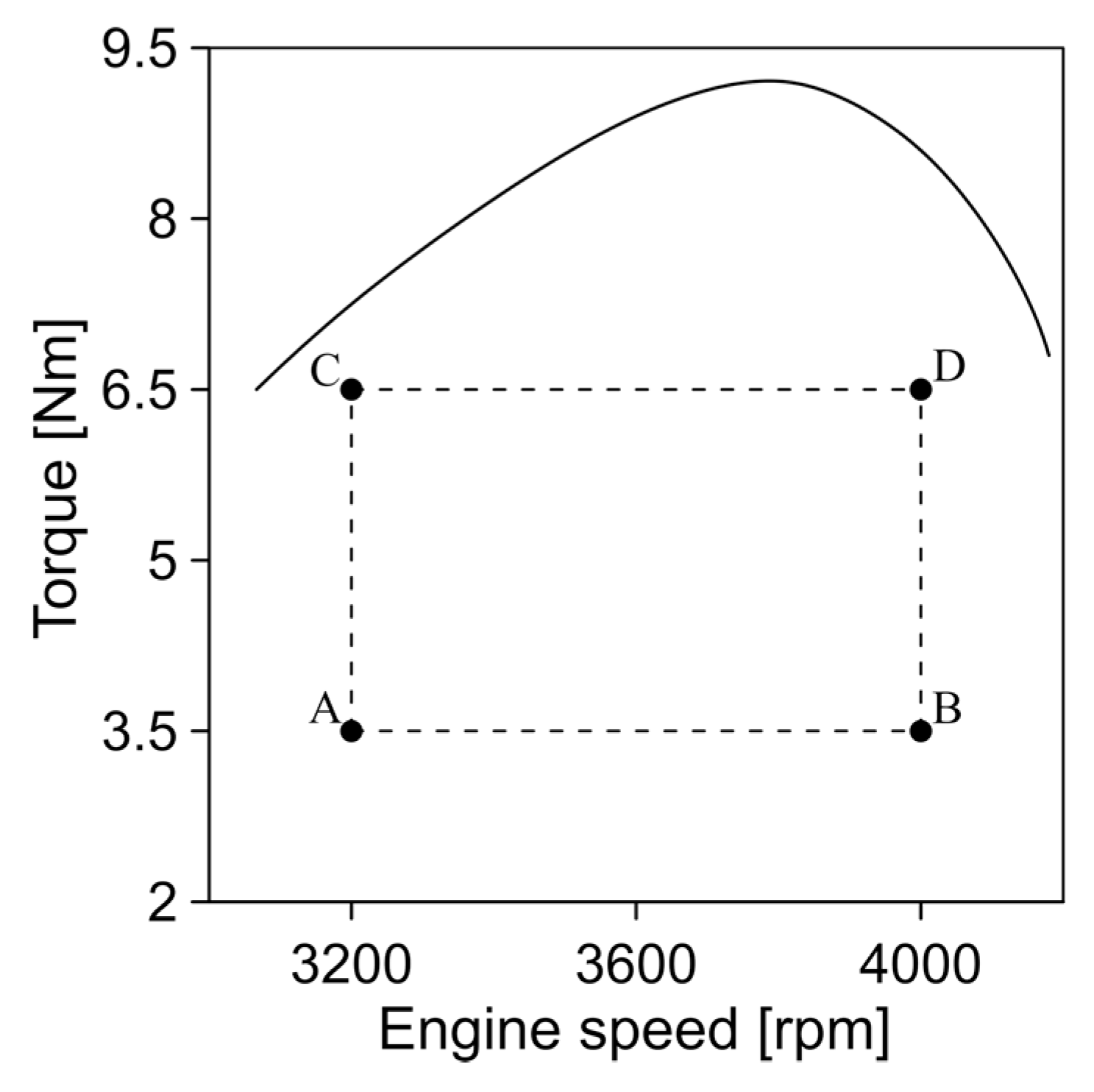
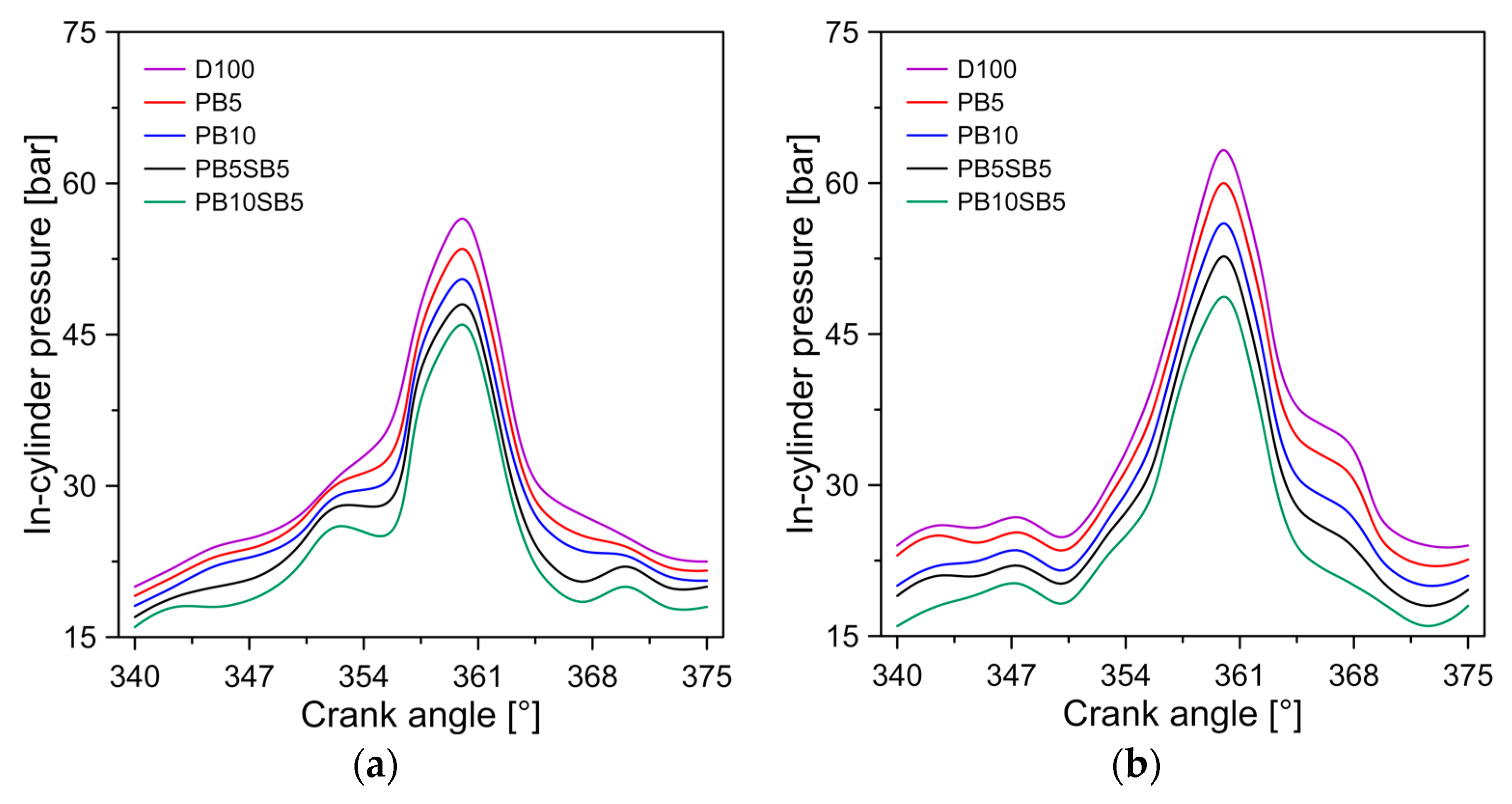
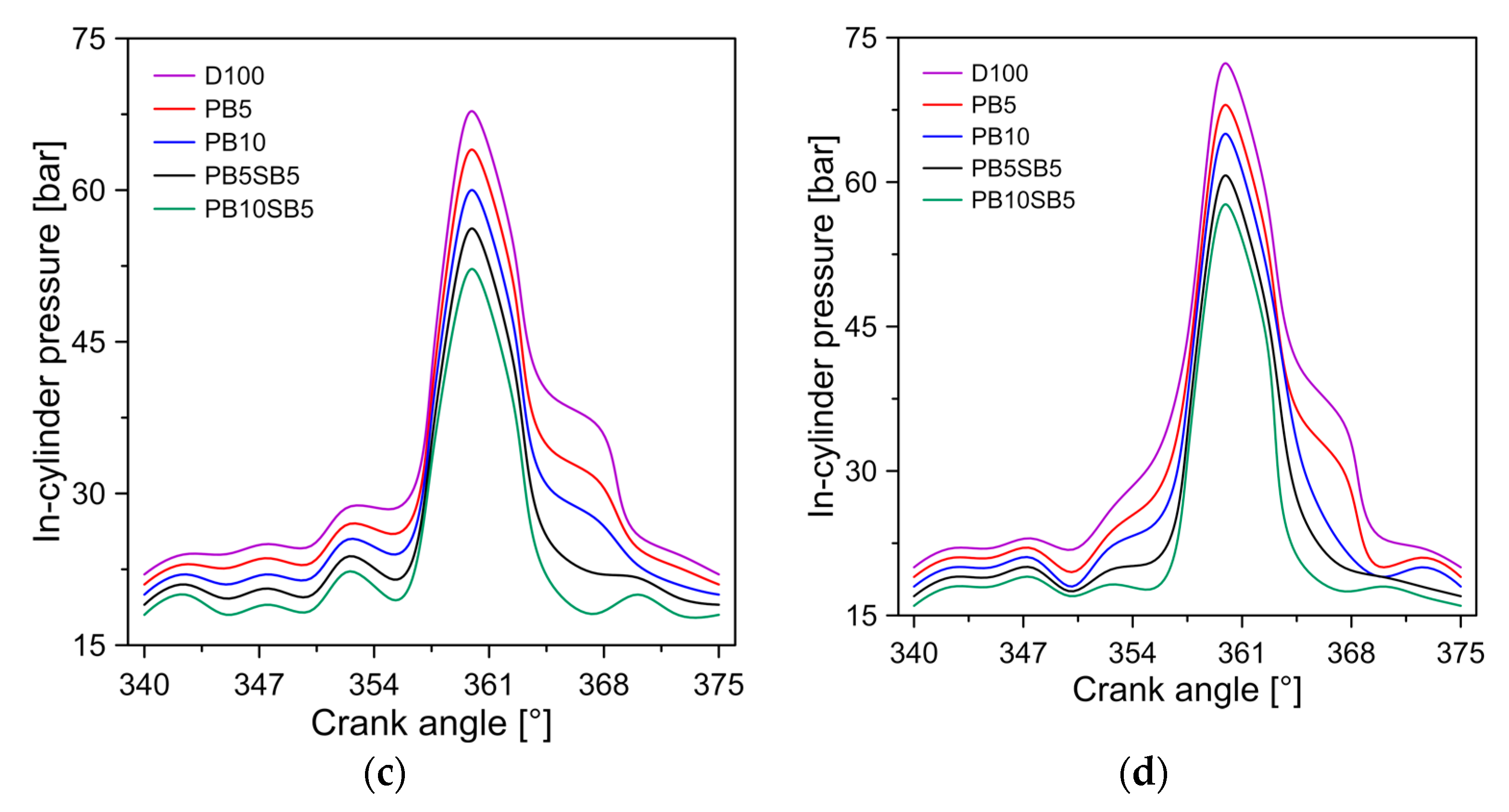
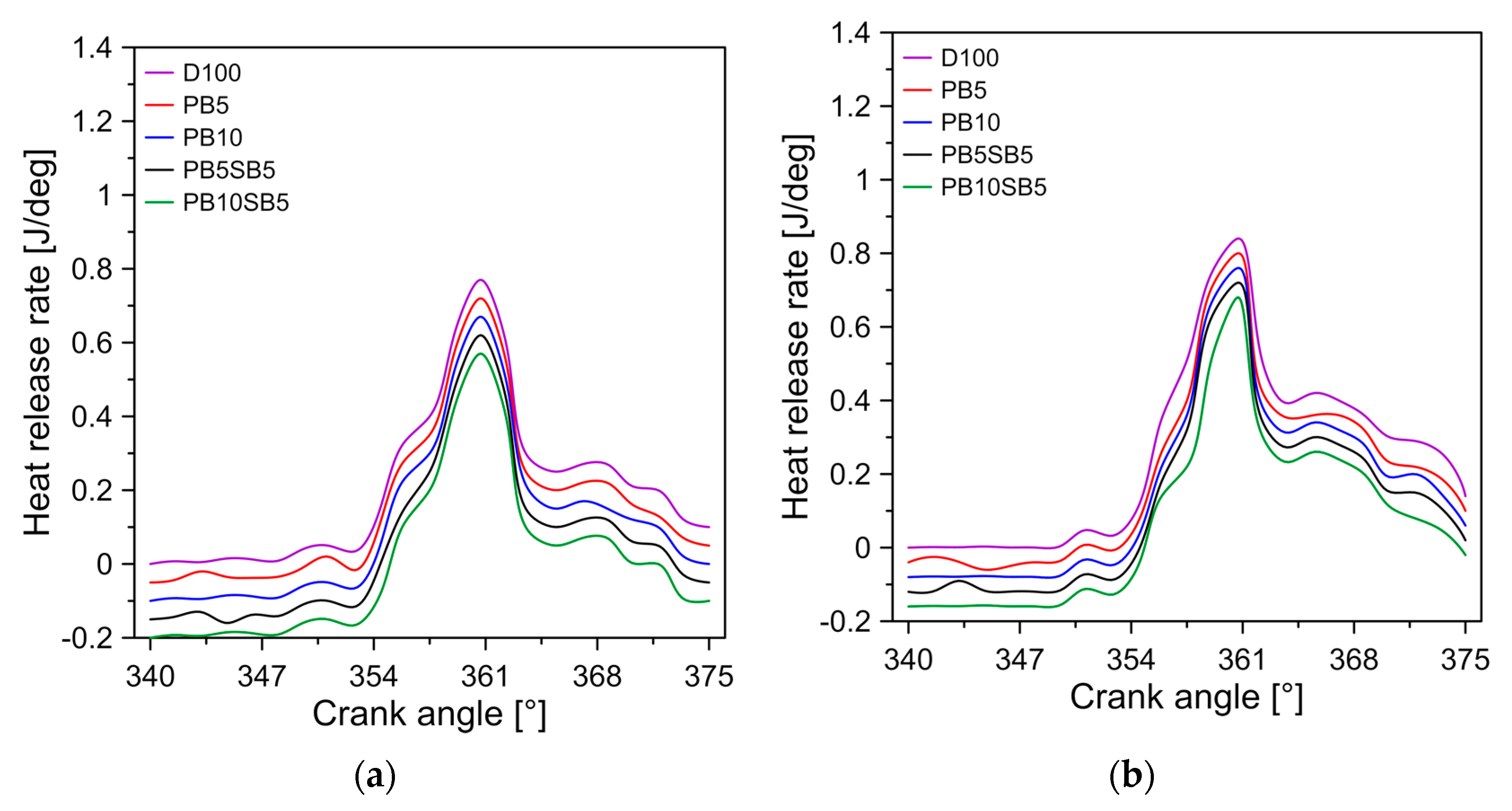


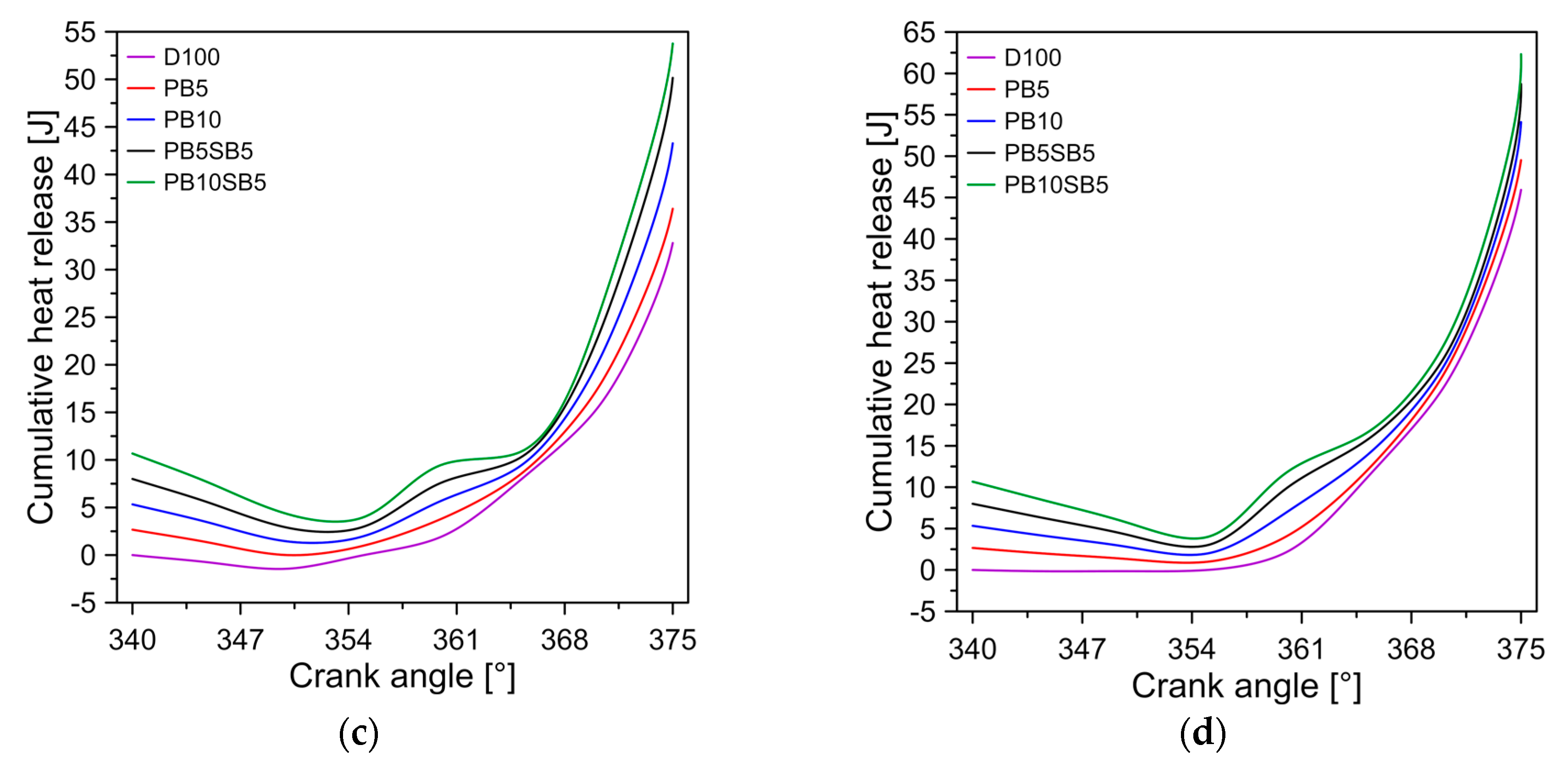

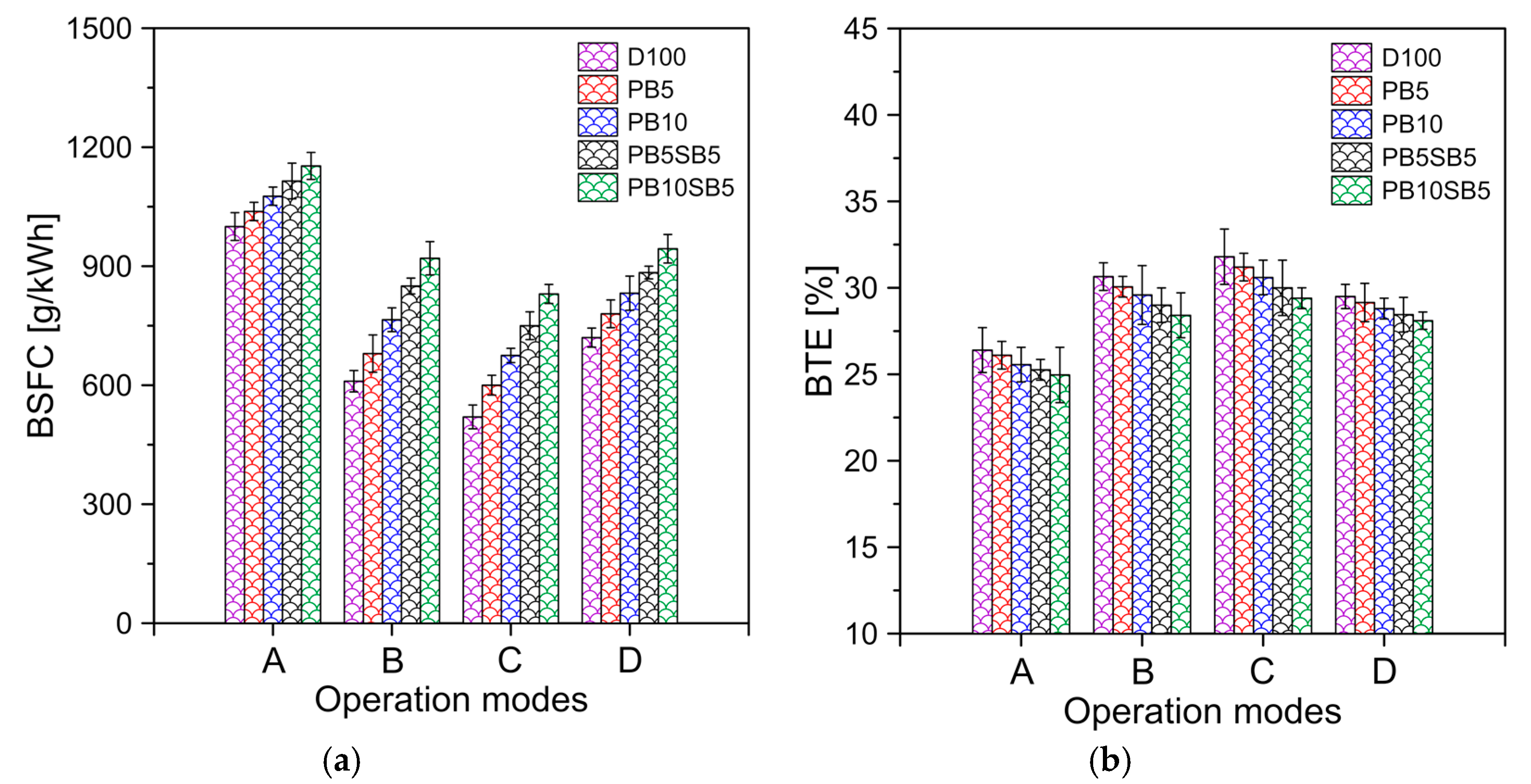
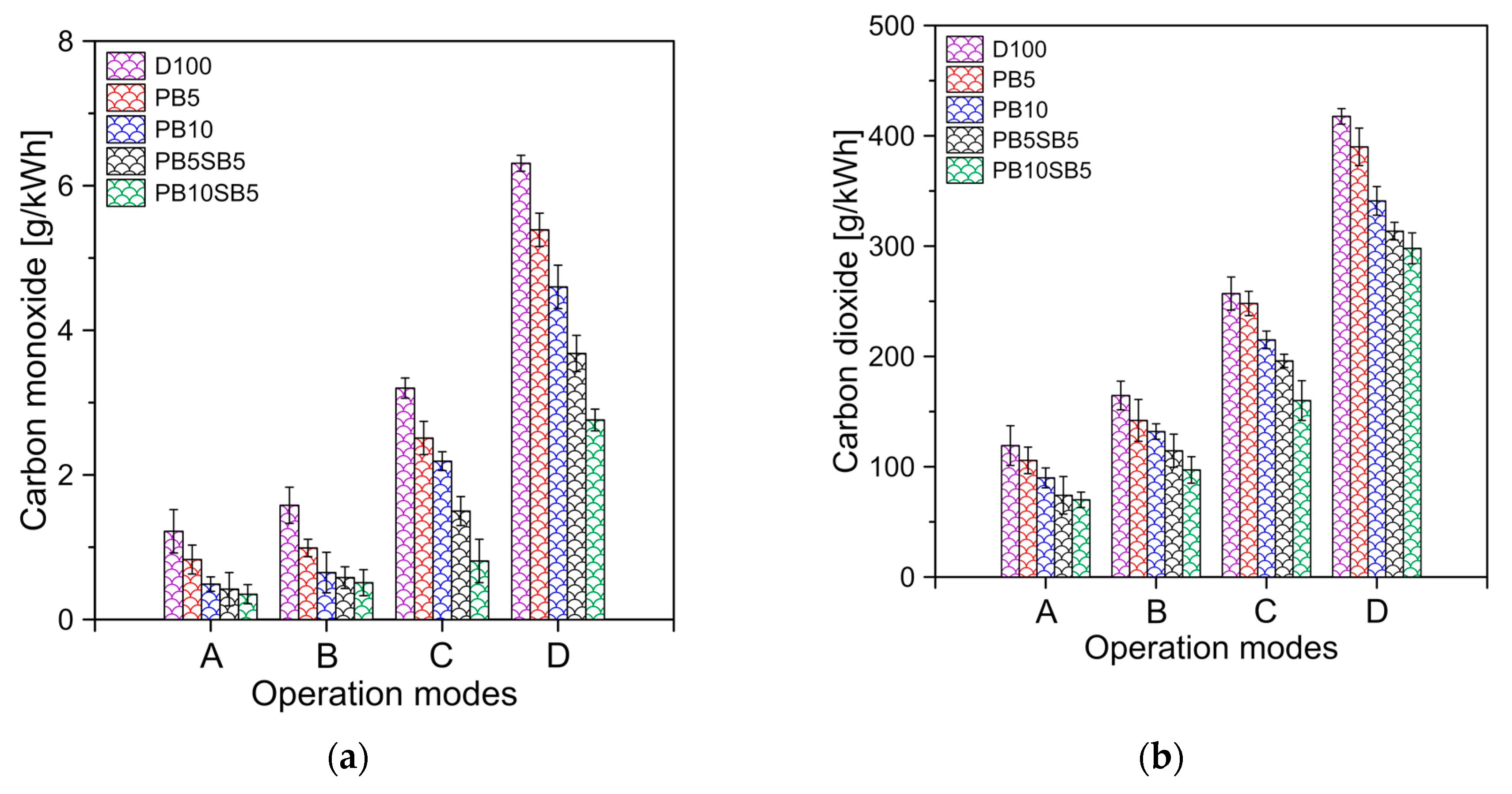


| Model | SK-MDF300 |
|---|---|
| Engine type | 1 cylinder |
| Manufacturer | SOKAN |
| Cycle | 4 Strokes |
| Bore × stroke | 78 mm × 62.57 mm |
| Displaced volume | 299 CC |
| Compression ratio | 20:1 |
| Maximum power | 4.6 hp at 3600 rpm |
| Intake system | Naturally Aspirated |
| Injection system | Direct injection |
| Injection Angle | 20° BTDC |
| Measuring Instrument | Manufacturer | Range | Accuracy | |
|---|---|---|---|---|
| Thermocouple | Type K | −200–1370 °C | 0.1% | |
| Piezoelectric transducer | KISTLER type 7063-A | 0–250 bar | <±0.5% | |
| Gravimetric meter | OHAUS PA313 | 0–310 g | 1% | |
| Hot wire | BOSCH 22680 7J600 | 0–125 g/s | 1% | |
| Hall effect | NJK-5002C | 5–9999 RPM | 0.03% | |
| Exhaust gas analyzer | BrainBee AGS-688 | CO | 0 ÷ 9.99 vol% | ±0.1% |
| CO2 | 0 ÷ 19.9 vol% | ±0.01% | ||
| HC | 0 ÷ 19.999 ppm | ±1% | ||
| PCA® 400 | NOx | 0 ÷ 3000 ppm | ±0.5% | |
| Smoke meter | BrainBee OPA-100 | 0 ÷ 99.9% | ±0.1% | |
| Nomenclature | Composition |
|---|---|
| D100 | Diesel 100% |
| PB5 | Diesel 95% + Palm oil biodiesel 5% |
| PB10 | Diesel 90% + Palm oil biodiesel 10% |
| PB5SB5 | Diesel 90% + Palm oil biodiesel 5% + Sunflower oil biodiesel 5% |
| PB10SB5 | Diesel 85% + Palm oil biodiesel 10% + Sunflower oil biodiesel 5% |
| Property | Units | Standards | D100 | PB5 | PB10 | PB5SB5 | PB10SB5 |
|---|---|---|---|---|---|---|---|
| Density | kg/m3 | ASTM D1298 | 821.5 | 823.1 | 827.5 | 829.1 | 833 |
| Viscosity | cSt | ASTM D445 | 2.64 | 2.65 | 2.66 | 2.68 | 2.69 |
| Flash point | °C | ASTM D93 | 76 | 85 | 96 | 98 | 100 |
| Cloud point | °C | ASTM D2500 | 6.5 | 7.2 | 8.3 | 8.5 | 9.1 |
| Pour point | °C | ASTM D97 | 3.1 | 3.5 | 3.8 | 4 | 4.3 |
| NCP | MJ/kg | ASTM D240 | 44.05 | 43.89 | 43.25 | 42.28 | 41.67 |
© 2020 by the authors. Licensee MDPI, Basel, Switzerland. This article is an open access article distributed under the terms and conditions of the Creative Commons Attribution (CC BY) license (http://creativecommons.org/licenses/by/4.0/).
Share and Cite
Valencia Ochoa, G.; Acevedo Peñaloza, C.; Duarte Forero, J. Combustion and Performance Study of Low-Displacement Compression Ignition Engines Operating with Diesel–Biodiesel Blends. Appl. Sci. 2020, 10, 907. https://doi.org/10.3390/app10030907
Valencia Ochoa G, Acevedo Peñaloza C, Duarte Forero J. Combustion and Performance Study of Low-Displacement Compression Ignition Engines Operating with Diesel–Biodiesel Blends. Applied Sciences. 2020; 10(3):907. https://doi.org/10.3390/app10030907
Chicago/Turabian StyleValencia Ochoa, Guillermo, Carlos Acevedo Peñaloza, and Jorge Duarte Forero. 2020. "Combustion and Performance Study of Low-Displacement Compression Ignition Engines Operating with Diesel–Biodiesel Blends" Applied Sciences 10, no. 3: 907. https://doi.org/10.3390/app10030907
APA StyleValencia Ochoa, G., Acevedo Peñaloza, C., & Duarte Forero, J. (2020). Combustion and Performance Study of Low-Displacement Compression Ignition Engines Operating with Diesel–Biodiesel Blends. Applied Sciences, 10(3), 907. https://doi.org/10.3390/app10030907







